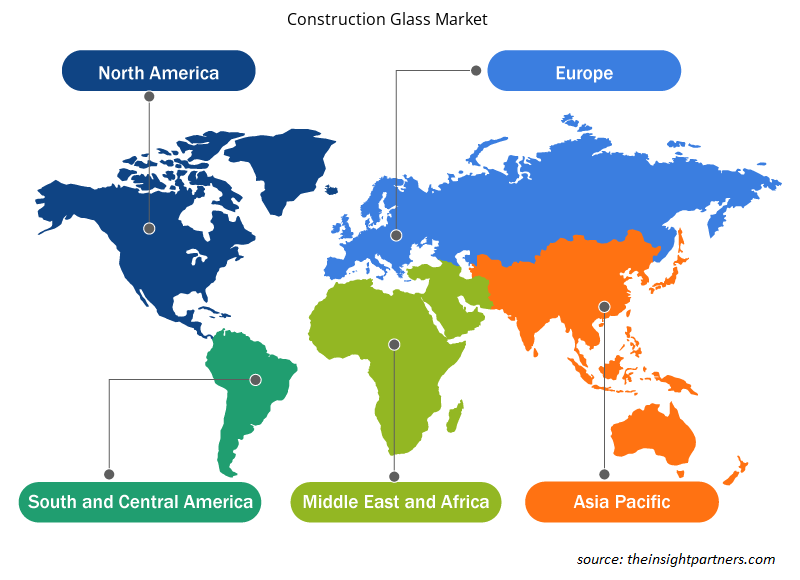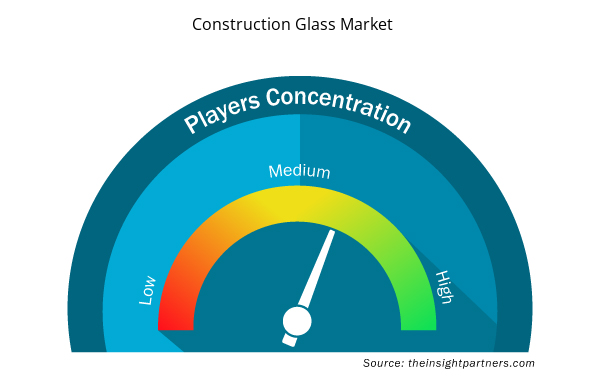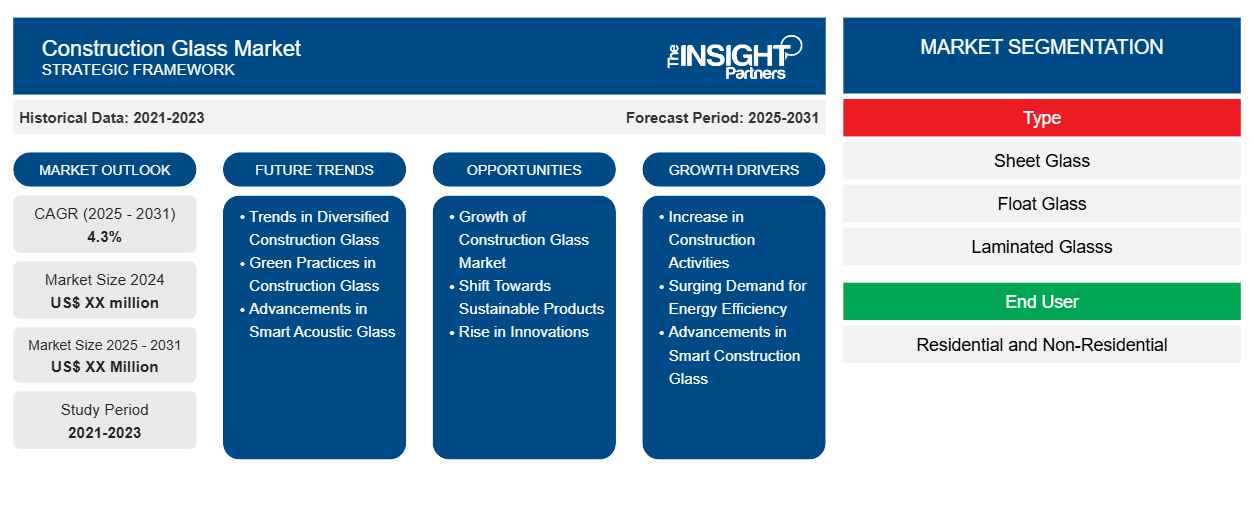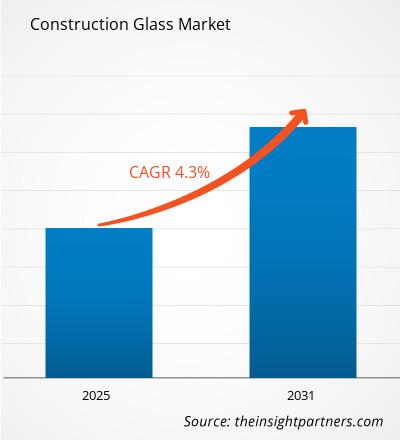Se espera que el mercado de vidrio para construcción registre una CAGR del 4,3 % entre 2024 y 2031, con un tamaño de mercado que se expandirá de US$ XX millones en 2024 a US$ XX millones en 2031.
El informe está segmentado por tipo (vidrio en láminas, vidrio flotado, vidrio laminado, vidrio irrompible y otros). El informe también está segmentado por usuario final (residencial y no residencial). El alcance del informe cubre 5 regiones: América del Norte, Europa, Asia Pacífico, Medio Oriente y África, y América del Sur y Central y los países clave de cada región. El análisis global se desglosa aún más a nivel regional y por países principales. El informe ofrece el valor en USD para el análisis y los segmentos anteriores.
Propósito del Informe
El informe Construction Glass Market de The Insight Partners tiene como objetivo describir el panorama actual y el crecimiento futuro, los principales factores impulsores, los desafíos y las oportunidades. Esto proporcionará información a diversas partes interesadas del negocio, como:
- Proveedores/fabricantes de tecnología: Para comprender la dinámica cambiante del mercado y conocer las oportunidades potenciales de crecimiento, lo que les permitirá tomar decisiones estratégicas informadas.
- Inversionistas: Realizar un análisis exhaustivo de tendencias sobre la tasa de crecimiento del mercado, las proyecciones financieras del mercado y las oportunidades que existen en toda la cadena de valor.
- Órganos reguladores: Regular las políticas y vigilar las actividades del mercado con el objetivo de minimizar los abusos, preservar la confianza de los inversores y defender la integridad y la estabilidad del mercado.
Segmentación del mercado del vidrio para la construcción
Tipo
- Vidrio en láminas
- Vidrio flotado
- Vidrios laminados
- Vidrio irrompible
Usuario final
- Residencial y no residencial
Personalice este informe según sus necesidades
Obtendrá personalización en cualquier informe, sin cargo, incluidas partes de este informe o análisis a nivel de país, paquete de datos de Excel, así como también grandes ofertas y descuentos para empresas emergentes y universidades.
- Obtenga las principales tendencias clave del mercado de este informe.Esta muestra GRATUITA incluirá análisis de datos, desde tendencias del mercado hasta estimaciones y pronósticos.
Factores impulsores del crecimiento del mercado del vidrio para la construcción
- Aumento de las actividades de construcción: el crecimiento cada vez mayor de las ciudades y de sus poblaciones genera una mayor necesidad de construcción de viviendas y comercios. La urbanización genera la necesidad de utilizar vidrio para la construcción en fachadas, ventanas y mejoras interiores. Esto genera una tendencia entre los fabricantes a crear mejores productos para mantenerse al día con la arquitectura moderna.
- Demanda creciente de eficiencia energética: muchos países están implementando regulaciones más estrictas sobre el control de la eficiencia energética de los edificios con el fin de prevenir el cambio climático. Los métodos de acristalamiento energéticamente eficientes, como el acristalamiento aislante o el vidrio de baja emisividad, son un aspecto claro del vidrio para construcción en estos requisitos. Estas poblaciones están aumentando a medida que se buscan materiales de construcción que permitan a los constructores cumplir con las legislaciones vigentes sin utilizar demasiada energía en los edificios.
- Avances en el vidrio inteligente para la construcción: el sector de la construcción está evolucionando debido a las mejoras en la producción de vidrio, como la tecnología de vidrio inteligente y el aumento de la resistencia a las ilusiones ópticas. Gracias a estos avances, ahora es posible crear vidrio que regule la temperatura, bloquee la luz solar y también brinde seguridad. La industria de la construcción también está avanzando a medida que los arquitectos y constructores buscan opciones exóticas, por lo que el vidrio de construcción de alto rendimiento está en demanda.
Tendencias futuras del mercado del vidrio para la construcción
- Tendencias en la diversificación del vidrio para la construcción: El mercado del vidrio para la construcción y la arquitectura parece estar encaminándose hacia la diversificación, ya que los fabricantes han ido ampliando sus gamas de productos para responder a los gustos cambiantes de los clientes. Estas tendencias incluyen la aparición de nuevos vidrios, como el vidrio de baja emisividad (low-e) y el vidrio inteligente, que están diseñados para aumentar la eficiencia energética y la utilidad de las estructuras contemporáneas.
- Prácticas ecológicas en el vidrio para la construcción: Si consideramos los aspectos relacionados con el vidrio para la construcción, la tendencia hacia prácticas sostenibles se hace aún más pronunciada. Debido a una mayor conciencia ambiental, los constructores y diseñadores están más preocupados por el uso de materiales ecológicos. Esto también presenta una oportunidad para la disponibilidad de vidrio reciclado, así como todos los demás materiales reciclados utilizados para construir edificios ecológicos, que forman parte de las campañas globales para promover la construcción ecológica.
- Avances en vidrio acústico inteligente: los avances en vidrio acústico son notables, al igual que la tecnología inteligente que se incorpora al vidrio de construcción. Por ejemplo, el vidrio inteligente puede cambiar su opacidad en función del clima, con el fin de mejorar la eficiencia energética y la comodidad de los habitantes. La razón es simple: cada vez más promotores inmobiliarios buscan mejoras que no solo mejoren el rendimiento del edificio, sino que también sean visualmente atractivas.
Oportunidades en el mercado del vidrio para la construcción
- Crecimiento del mercado del vidrio para la construcción: El mercado del vidrio para la construcción tiene un amplio margen para crecer en los países emergentes donde la urbanización y el desarrollo de infraestructuras se están produciendo a un ritmo acelerado. Asia y África se están centrando actualmente en el desarrollo de los sectores residencial y comercial en sus países, lo que da lugar a una mayor necesidad de vidrio para la construcción. Esto, a su vez, puede conducir a una mejora de la cuota de mercado de dichos productores.
- Cambio hacia productos sostenibles: dado que la sostenibilidad es una prioridad en muchos países, las tasas de construcción de productos de naturaleza sostenible están aumentando. El vidrio para construcción que está certificado según los estándares de construcción ecológica, como el vidrio de baja emisividad y el vidrio reciclado, brinda a los fabricantes la oportunidad de ingresar a este mercado altamente competitivo. Esto también está en consonancia con las legislaciones que fomentan la construcción y los materiales de construcción que ahorran energía.
- Aumento de las innovaciones: las nuevas tecnologías en acristalamiento, como el acristalamiento inteligente y los revestimientos que ahorran energía, están marcando el comienzo de un nuevo crecimiento. Estas innovaciones sirven para mejorar los edificios y los niveles de confort de los materiales, lo que los hace atractivos para los contratistas. Con la aceptación de las nuevas tecnologías que definen estos mercados, existen oportunidades para que las empresas desarrollen su propia marca, lo que a su vez conducirá a mayores resultados en la cuota de mercado del vidrio para la construcción.
Perspectivas regionales del mercado del vidrio para la construcción
Los analistas de Insight Partners explicaron en detalle las tendencias y los factores regionales que influyen en el mercado del vidrio para la construcción durante el período de pronóstico. Esta sección también analiza los segmentos y la geografía del mercado del vidrio para la construcción en América del Norte, Europa, Asia Pacífico, Oriente Medio y África, y América del Sur y Central.

- Obtenga datos regionales específicos para el mercado de vidrio para construcción
Alcance del informe sobre el mercado del vidrio para la construcción
| Atributo del informe | Detalles |
|---|---|
| Tamaño del mercado en 2024 | XX millones de dólares estadounidenses |
| Tamaño del mercado en 2031 | US$ XX millones |
| CAGR global (2024 - 2031) | 4,3% |
| Datos históricos | 2021-2023 |
| Período de pronóstico | 2025-2031 |
| Segmentos cubiertos | Por tipo
|
| Regiones y países cubiertos | América del norte
|
| Líderes del mercado y perfiles de empresas clave |
|
Densidad de actores del mercado del vidrio para la construcción: comprensión de su impacto en la dinámica empresarial
El mercado del vidrio para la construcción está creciendo rápidamente, impulsado por la creciente demanda de los usuarios finales debido a factores como la evolución de las preferencias de los consumidores, los avances tecnológicos y una mayor conciencia de los beneficios del producto. A medida que aumenta la demanda, las empresas amplían sus ofertas, innovan para satisfacer las necesidades de los consumidores y aprovechan las tendencias emergentes, lo que impulsa aún más el crecimiento del mercado.
La densidad de actores del mercado se refiere a la distribución de las empresas o firmas que operan dentro de un mercado o industria en particular. Indica cuántos competidores (actores del mercado) están presentes en un espacio de mercado determinado en relación con su tamaño o valor total de mercado.
Las principales empresas que operan en el mercado del vidrio para la construcción son:
- China Glass Holdings Limited
- Vidrio Asahi
- Saint Gobain
- Schott AG
- Xinyi Glass Holdings Limited
Descargo de responsabilidad : Las empresas enumeradas anteriormente no están clasificadas en ningún orden particular.

- Obtenga una descripción general de los principales actores clave del mercado del vidrio para la construcción
Puntos de venta clave
- Cobertura integral: el informe cubre de manera integral el análisis de productos, servicios, tipos y usuarios finales del mercado de vidrio de construcción, proporcionando un panorama holístico.
- Análisis de expertos: el informe se compila sobre la base de un profundo conocimiento de expertos y analistas de la industria.
- Información actualizada: El informe asegura relevancia comercial debido a su cobertura de información reciente y tendencias de datos.
- Opciones de personalización: este informe se puede personalizar para satisfacer los requisitos específicos del cliente y adaptarse adecuadamente a las estrategias comerciales.
Por lo tanto, el informe de investigación sobre el mercado del vidrio para la construcción puede ayudar a abrir camino para descifrar y comprender el escenario de la industria y las perspectivas de crecimiento. Si bien puede haber algunas preocupaciones válidas, los beneficios generales de este informe tienden a superar las desventajas.
- Análisis histórico (2 años), año base, pronóstico (7 años) con CAGR
- Análisis PEST y FODA
- Tamaño del mercado Valor/volumen: global, regional, nacional
- Industria y panorama competitivo
- Conjunto de datos de Excel


- Aircraft Wire and Cable Market
- Hydrogen Compressors Market
- Queue Management System Market
- Semiconductor Metrology and Inspection Market
- Artificial Intelligence in Defense Market
- Pressure Vessel Composite Materials Market
- Cell Line Development Market
- Saudi Arabia Drywall Panels Market
- Small Molecule Drug Discovery Market
- Grant Management Software Market

Report Coverage
Revenue forecast, Company Analysis, Industry landscape, Growth factors, and Trends

Segment Covered
This text is related
to segments covered.

Regional Scope
North America, Europe, Asia Pacific, Middle East & Africa, South & Central America

Country Scope
This text is related
to country scope.
Preguntas frecuentes
Based on geography, Asia Pacific is expected to register the fastest CAGR from 2023 to 2031.
The report can be delivered in PDF/Word format, we can also share excel data sheet based on request.
SCHOTT, Nippon Sheet Glass Co Ltd, Saint-Gobain, Guardian Industries Holdings, Asahi India Glass Ltd, Central Glass Co Ltd, Corning Incorporated, Sisecam, Bendheim, and Pella Corporation are among the leading players operating in the construction glass market.
Rising urbanization is driving the market growth
Growth of green building initiatives is one of the key opportunities for the market growth.
The Construction Glass Market is estimated to witness a CAGR of 4.3% from 2023 to 2031
Trends and growth analysis reports related to Chemicals and Materials : READ MORE..
The List of Companies
- China Glass Holdings Limited
- Asahi Glass
- Saint-Gobain
- Schott AG
- Xinyi Glass Holdings Limited
- Central Glass Co. Ltd.
- PPG Industries, Inc.
- Sisecam Group
- Nippon Sheet Glass Co. LTD.
- Bendheim Glass
The Insight Partners performs research in 4 major stages: Data Collection & Secondary Research, Primary Research, Data Analysis and Data Triangulation & Final Review.
- Data Collection and Secondary Research:
As a market research and consulting firm operating from a decade, we have published and advised several client across the globe. First step for any study will start with an assessment of currently available data and insights from existing reports. Further, historical and current market information is collected from Investor Presentations, Annual Reports, SEC Filings, etc., and other information related to company’s performance and market positioning are gathered from Paid Databases (Factiva, Hoovers, and Reuters) and various other publications available in public domain.
Several associations trade associates, technical forums, institutes, societies and organization are accessed to gain technical as well as market related insights through their publications such as research papers, blogs and press releases related to the studies are referred to get cues about the market. Further, white papers, journals, magazines, and other news articles published in last 3 years are scrutinized and analyzed to understand the current market trends.
- Primary Research:
The primarily interview analysis comprise of data obtained from industry participants interview and answers to survey questions gathered by in-house primary team.
For primary research, interviews are conducted with industry experts/CEOs/Marketing Managers/VPs/Subject Matter Experts from both demand and supply side to get a 360-degree view of the market. The primary team conducts several interviews based on the complexity of the markets to understand the various market trends and dynamics which makes research more credible and precise.
A typical research interview fulfils the following functions:
- Provides first-hand information on the market size, market trends, growth trends, competitive landscape, and outlook
- Validates and strengthens in-house secondary research findings
- Develops the analysis team’s expertise and market understanding
Primary research involves email interactions and telephone interviews for each market, category, segment, and sub-segment across geographies. The participants who typically take part in such a process include, but are not limited to:
- Industry participants: VPs, business development managers, market intelligence managers and national sales managers
- Outside experts: Valuation experts, research analysts and key opinion leaders specializing in the electronics and semiconductor industry.
Below is the breakup of our primary respondents by company, designation, and region:

Once we receive the confirmation from primary research sources or primary respondents, we finalize the base year market estimation and forecast the data as per the macroeconomic and microeconomic factors assessed during data collection.
- Data Analysis:
Once data is validated through both secondary as well as primary respondents, we finalize the market estimations by hypothesis formulation and factor analysis at regional and country level.
- Macro-Economic Factor Analysis:
We analyse macroeconomic indicators such the gross domestic product (GDP), increase in the demand for goods and services across industries, technological advancement, regional economic growth, governmental policies, the influence of COVID-19, PEST analysis, and other aspects. This analysis aids in setting benchmarks for various nations/regions and approximating market splits. Additionally, the general trend of the aforementioned components aid in determining the market's development possibilities.
- Country Level Data:
Various factors that are especially aligned to the country are taken into account to determine the market size for a certain area and country, including the presence of vendors, such as headquarters and offices, the country's GDP, demand patterns, and industry growth. To comprehend the market dynamics for the nation, a number of growth variables, inhibitors, application areas, and current market trends are researched. The aforementioned elements aid in determining the country's overall market's growth potential.
- Company Profile:
The “Table of Contents” is formulated by listing and analyzing more than 25 - 30 companies operating in the market ecosystem across geographies. However, we profile only 10 companies as a standard practice in our syndicate reports. These 10 companies comprise leading, emerging, and regional players. Nonetheless, our analysis is not restricted to the 10 listed companies, we also analyze other companies present in the market to develop a holistic view and understand the prevailing trends. The “Company Profiles” section in the report covers key facts, business description, products & services, financial information, SWOT analysis, and key developments. The financial information presented is extracted from the annual reports and official documents of the publicly listed companies. Upon collecting the information for the sections of respective companies, we verify them via various primary sources and then compile the data in respective company profiles. The company level information helps us in deriving the base number as well as in forecasting the market size.
- Developing Base Number:
Aggregation of sales statistics (2020-2022) and macro-economic factor, and other secondary and primary research insights are utilized to arrive at base number and related market shares for 2022. The data gaps are identified in this step and relevant market data is analyzed, collected from paid primary interviews or databases. On finalizing the base year market size, forecasts are developed on the basis of macro-economic, industry and market growth factors and company level analysis.
- Data Triangulation and Final Review:
The market findings and base year market size calculations are validated from supply as well as demand side. Demand side validations are based on macro-economic factor analysis and benchmarks for respective regions and countries. In case of supply side validations, revenues of major companies are estimated (in case not available) based on industry benchmark, approximate number of employees, product portfolio, and primary interviews revenues are gathered. Further revenue from target product/service segment is assessed to avoid overshooting of market statistics. In case of heavy deviations between supply and demand side values, all thes steps are repeated to achieve synchronization.
We follow an iterative model, wherein we share our research findings with Subject Matter Experts (SME’s) and Key Opinion Leaders (KOLs) until consensus view of the market is not formulated – this model negates any drastic deviation in the opinions of experts. Only validated and universally acceptable research findings are quoted in our reports.
We have important check points that we use to validate our research findings – which we call – data triangulation, where we validate the information, we generate from secondary sources with primary interviews and then we re-validate with our internal data bases and Subject matter experts. This comprehensive model enables us to deliver high quality, reliable data in shortest possible time.


 Obtenga una muestra gratuita de este informe
Obtenga una muestra gratuita de este informe